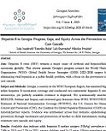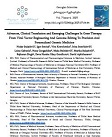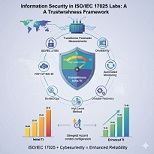Management and control system for landslide-prone areas
Downloads
This article describes a system for managing and controlling landslide-prone areas. The article discusses the use of intelligent technologies in the context of information technologies and their importance. It also describes methods for landslide occurrence and detection, including inclinometric, geodetic, laser and fiber-optic systems. The article focuses on the problems of landslide-prone areas in Georgia and ways to solve them, including the creation of flexible early warning systems. It also discusses the use of geoinformation systems for monitoring landslide-prone areas. The paper discusses in detail methods for landslide occurrence and detection, such as inclinometric measurements, geodetic methods, laser and fiber-optic systems. Special attention is paid to the shortcomings of existing systems, such as high cost and inflexibility, which arise from the diversity of the Georgian terrain. The system developed by the authors aims to create a flexible and low-cost early warning system that will allow for timely detection of natural hazards in critical areas of the country. The resulting system includes measuring soil displacement, slope, and deformation using Hall sensors that send data to a central server using GPS technology. Data analysis is performed using special software, which allows users to individually and timely assess risks. In addition, the paper emphasizes the importance of geoinformation technologies in the process of terrain analysis and monitoring of landslide-prone areas. The technologies used provide effective implementation in many areas, such as geological analysis, infrastructure management, and safety improvement. The research has laid the foundation for the creation of an innovative system that is consistent with the geological and climatic specifics of Georgia, thereby significantly improving public safety and regional resilience.
Downloads
Copyright (c) 2024 Georgian Scientists

This work is licensed under a Creative Commons Attribution-NonCommercial-NoDerivatives 4.0 International License.










































































































































































































